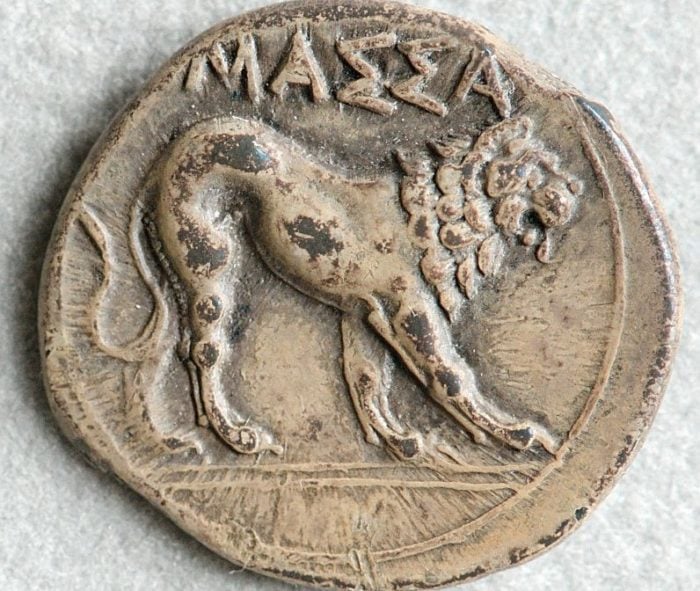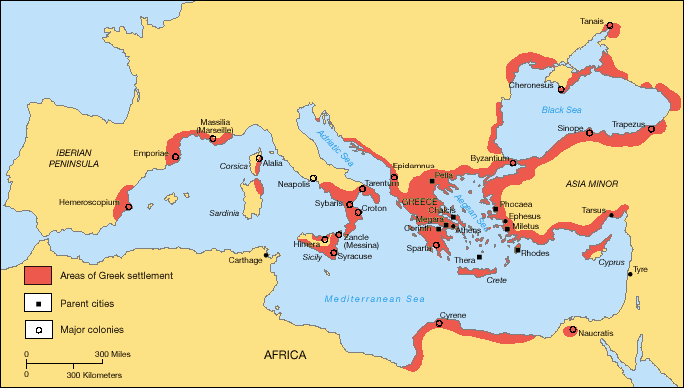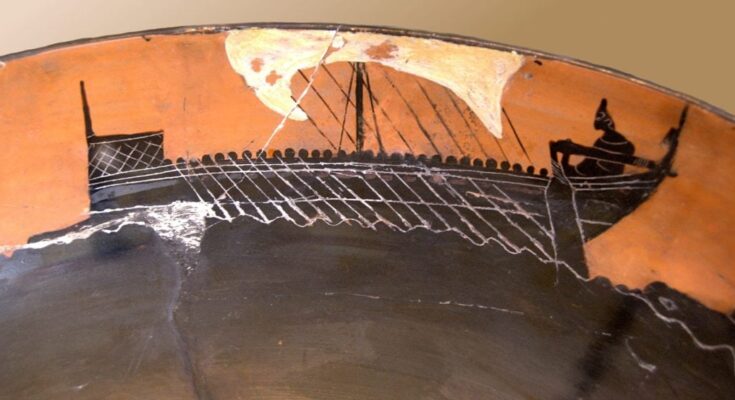
The first ancient Greek colonies were established as early as the 8th century BC, while wide colonization continued through the fifth century BC.
A number of cities and settlements were established, spreading Hellenism in Europe, Africa and Asia during those centuries, reaching a total of 500 — which involved up to 60,000 Greek citizen colonists.
The founding of the colonies (αποικίαι, singular αποικία) was an organized endeavor of the larger city-states, although in many cases it came about through a collaboration of cities.
The places to be colonized were carefully selected in advance, based on not only their potential business advantages but also for offering security from raiders.
However, there were other reasons, too. Some of the city-states were forced to colonize because of famines, natural disasters and overpopulation.
By 500 BC these new territories would eventually account for an incredible 40 percent of all Greeks in the Hellenic World.
Ancient Greek colonies of the 8th century BC
Restless and adventurous spirits, the ancient Greeks defied natural dangers and the fear of the unknown, and began to look for new places to settle in even before the 8th century BC.
The cities of Rhodes, even before 800 BC, founded settlements in Tarsus of Cilicia. They were followed by Evian cities in Tarsus and Al-Mina, a city just across the sea from Cyprus.
The Evian cities, among the leaders in ancient Greek colonization, also established colonies in Halkidiki, Macedonia, at the beginning of the 8th century BC.
The first Greek colony created outside of present-day Greece was located in the Pithekousai islands (today’s Ischia, Italy).
The colony was created by Chalcidians and Eretrians between 770 and 760 BC. A few years later, the inhabitants of Chalkis and Kymi founded Kymi, opposite the Pithekousai Islands, in today’s Campania on mainland Italy.
By the year 734 BC, Greeks began the systematic colonization of Sicily: Naxos in Sicily, Syracuse, Catania, Leontines, Megara Hyblaea, and Mylai in Sicily were all founded before the year 700 BC.
At the same time, Greek colonies began to be established in southern Italy, with Taranto, Sybaris and Kroton (Crotone) and Rhegium.
Taranto was among the most important in all of Magna Graecia, becoming a cultural, economic and military power that gave birth to philosophers, strategists, writers and athletes.

Southern Mediterranean and Magna Graecia
From 700 BC to 500 BC the Greek colonies in the regions of Sicily and present-day mainland Italy multiplied, creating the area known as Magna Graecia.
According to modern historian Mogens Herman Hansen, more than 46 Greek colonies were founded in Sicily and more than 22 in southern Italy.
A “second Greece” of a kind was formed in these areas, which amounted to a population and area that was just a little smaller than metropolitan Greece, hence the name Magna Graecia.
The newer Greek residents were mostly from Rhodes and Crete as well as the Achaeans of Messinia. However, not all Greek colonies in today’s Italy were established peacefully.
Older settlers in these cities owned large estates cultivated by indigenous slaveholders; they formed a very insular aristocracy that reacted negatively to the economic and political advancement of the younger settlers.
Shortly before 600 BC the Rhodians founded Parthenope, the forerunner of Naples. At the same time, Greeks from Evia lived on the islands of Pontia and Pandateira (now Capri).
The great Syracuse in Ancient Greece
Syracuse, also known as Siracusa, was founded by Corinthian settlers in 733 BC, the second Greek city to be founded on the island after Naxos.
The natives were well-disposed towards the Greek colonists, and Syracuse soon grew in size until it became the most powerful Greek city-state in Sicily and the Mediterranean.
In 485 BC, Gelon seized power as a tyrant and resettled the inhabitants of Gela, Kamarina, and Megara in Syracuse, building the new Tyche and Neapolis quarters outside the city walls.
By 415 BC, Syracuse had 250,000 residents and was equal in size to Athens; the city went on to make expeditions up to Corsica and Elba, defeating the powerful Carthaginian empire at the Battle of Himera and the ancient Etruscans at the Battle of Cumae.
From 415 to 413 BC, during the Peloponnesian War, Syracuse along with Spartan forces, helped to repel the Athenians’ Sicilian Expedition.
Sybaris and the Sybarites
Another important Greek colony of Magna Graecia was Sybaris. It was situated on the Gulf of Taranto, in southern Italy, between two rivers, the Crathis (Crati) and the Sybaris (Coscile).
Sybaris was founded in 720 BC by Achaean and Troezenian settlers. The city had a busy port and fertile land, and soon amassed great wealth.
The wealth of Sybaris made its citizens famous for their hedonism, feasts, and excesses, to the extent that “sybarite” and “sybaritic” became synonyms for opulence, luxury, and outrageous pleasure-seeking.
However, in 510 BC the city was subjugated by its neighbor Kroton and its population driven out. Sybaris became a dependent ally of Kroton, but Kroton again besieged the city in 476 BC and occupied it.
The Sybarites reoccupied their city and expelled the Krotoniates 30 years later with the assistance of new settlers from Athens and other cities in the Peloponnese.
However, the Sybarites could not coexist with the new settlers and soon found themselves in a new conflict with them.
The Sybarites were ousted from their lands for the last time in the summer of 445 BC.
The new settlers then proceeded to found the city of Thurii in 443 BC, a new colony which was built partially on top of the site of Sybaris. The surviving Sybarites founded yet another new colony, called “Sybaris on the Traeis.”
Greek colonies in the western Mediterranean
The Phocaeans made a great contribution to the establishment of Greek colonies in the western Mediterranean, as mentioned by the historian Thucydides.
Due to their commercial activity, the Phocaeans founded many cities in southern Gaul, (today’s France), and also introduced the cult of goddess Artemis.
The first is Massalia (Marseilles), which was settled by them around 600 BC. From the beginning, the Greeks made sure to have good relations with the Gauls. Greek goods were then transported inland from Massalia.
On the same coast the Phocaeans also built Olbia and the Massaliotes Nicaea and Antipolis. Other Greek colonies such as Agde, Nice, Antibes and Monaco were added. The Phocaeans also founded settlements in the island of Corsica, such as at Alalia.
Along the west coast, in the Iberian Peninsula, from north to south, the Phocaeans founded Emporiae and Rhoda, the latter established by people from Rhodes.
The ruins of Emporiae can still be seen in the province of Girona, which belongs to Catalonia; it is the westernmost Greek colony in which archaeological traces still exist.
Eastern Mediterranean and North Africa
Around 630 BC, Greek settlers founded Cyrene, in today’s Libya. After 570 BC, the city experienced great prosperity as it strengthened in population with new settlers, including Peloponnesians, Cretans and other islanders.
It was the oldest and most important of the five Greek cities known as the “pentapoleis” (meaning “five cities” in Greek), in the region.
After the middle of the 7th century BC, Milesians built the Milesian Wall in the Nile Delta. After they helped Pharoah Psamtik I defeat his rival Inaros, he gave them new land to settle.
Thus they founded the port city of Naucratis, in 615 BC, which soon attracted merchants who came for the most part from the islands of the Eastern Aegean and Asia Minor.
Greeks also built the city of Heracleion, just outside Alexandria, which became an important port for Greek trade. It was there that they built the famous temple of Heracles.
Propontis and the Black Sea
The last area colonized by the Ancient Greeks was the Black Sea, or Euxine Sea, as it was called by them. It was the Ionians in this case, who were the colonizers; they desired to take advantage of the fishing resources and and the agricultural areas around the Hellespont and Pontos.
The first to establish colonies there where the people of Miletos, who were said to have founded a total 70 poleis on the fertile land and sea coast of the area.
The people of Megara founded the great Chalcedon in 685 BC, Byzantium in 668 BC and Herakleia Pontike in 560 BC.
Important poleis such as Kyzikos, founded around 675 BC, Sinope, ,which was settled in 631 BC, Pantikapaion, which was founded in 600 BC, and Olbia, which was settled in 550 BC, were established by the Ionian people.
The Aeolians founded Sistos after 700 BC, the Phocaeans founded Lampsacus a little later, while around 600 BC Samians settled Perinthos.
Sinope created new colonies in Kytoro, Kerasounta, Kotyora, Kromna, Pterion, Tion and elsewhere.
Eventually, almost the entire Black Sea was enclosed by Greek colonies by any means necessary — including war, diplomacy and intermarriages with indigenous peoples in order to ensure the colonies’ survival.
In fact, in the late 6th century BC, the Greek colonies provided money and arms to the Persian Empire and received protection in return.
After Xerxes failed to invade Greece in 480 and 479 BC, the Persians withdrew from the area, which allowed the larger poleis like Herakleia Pontike and Sinope to expand through the conquest of local populations and smaller neighboring poleis.
As a result, Herakleia found colonies of her own in the 420s BC in areas such as Chersonesos in the Crimea.
From the beginning of the Peloponnesian War in 431 BC, Athens took an interest in the region, sending out colonists and establishing garrisons, but the endeavor was short-lived.
With the eventual withdrawal of Athens, the Greek colonies were left to fend for themselves and meet alone the threat from neighboring powers such as the Royal Scythians — and, ultimately, Macedonia and Philip II.



